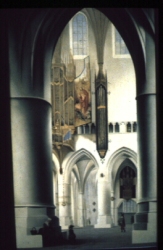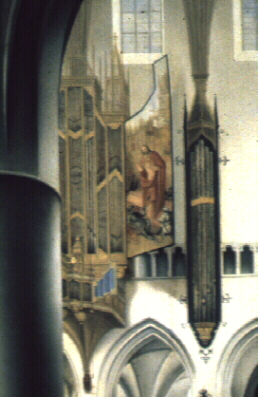

The Fifteenth Century |
By the fifteenth century, organs were being built with several characteristics which would become standard elements of design for the next several centuries.
To judge from extant sources of information, organs of the fifteenth century had developed from the easily-classified three sizes of the Middle Ages to a point that we can find in them many of the fundamental features that are still characteristic of the instrument today. That is, we know that during the fifteenth century, at least some instruments in different parts of Europe had:
We may never know just how some of these new characteristics seen in organs were developed, or when they originated, who first introduced them to organ-building, or what path they followed as they spread from one region to another. Furthermore, we don't have any complete instruments that survive in an unaltered state, so we can't even look at them or listen to them. However, using the information we do know from the sources mentioned above, we can draw some conclusions about the organ in general during the fifteenth century.
 There are fewer
surviving paintings and manuscript illuminations of large organs than there are
of
either portative or positive organs. One important painting that gives us a
good
idea of the appearance of at least one instrument of the late Gothic period is
the
one seen at
the left,
completed by P. Saenredam in 1636. 95 The painting shows the
interior of the Grote Kerk in Haarlem, with the organ of 1466 prominently
displayed.
The first
thing to notice about the organ is its placement: it is on the side wall of the
nave,
not
in a rear gallery. The
particular style of balcony that supports the instrument is a type called a
"swallow's nest," with a base that extends downward to a point. This shape is a
typical type of support for an organ of the Gothic period that is placed high on
a
wall of a church, as this one is. A set of bordunen, mentioned above as
a
late feature
of Blockwerk organ, is clearly visible on the wall, outside the main case.
There are fewer
surviving paintings and manuscript illuminations of large organs than there are
of
either portative or positive organs. One important painting that gives us a
good
idea of the appearance of at least one instrument of the late Gothic period is
the
one seen at
the left,
completed by P. Saenredam in 1636. 95 The painting shows the
interior of the Grote Kerk in Haarlem, with the organ of 1466 prominently
displayed.
The first
thing to notice about the organ is its placement: it is on the side wall of the
nave,
not
in a rear gallery. The
particular style of balcony that supports the instrument is a type called a
"swallow's nest," with a base that extends downward to a point. This shape is a
typical type of support for an organ of the Gothic period that is placed high on
a
wall of a church, as this one is. A set of bordunen, mentioned above as
a
late feature
of Blockwerk organ, is clearly visible on the wall, outside the main case.
It is important to realize that this organ no doubt incorporates elements that were well-established when the organ was built. At the same time, there must be characteristics that were relatively new in the fifteenth century. From our point of view -- over 500 years later -- we can look at the instrument depicted in this painting and see both the old and the new. We can look at it and see what the organ would become later, what this one contains that would be built on in later instruments, what would be left behind and what would lead ultimately to the grand instruments of later centuries.
 Let's look again at the painting of the Grote Kerk organ,
and see what fifteenth-century characteristics can be found there. In the enlarged
view to the right, we can see several important
characteristics:
Let's look again at the painting of the Grote Kerk organ,
and see what fifteenth-century characteristics can be found there. In the enlarged
view to the right, we can see several important
characteristics:
During the fifteenth century, regional differences began to appear. Organs from the north took on several characteristics (multiple manuals, for example) that were to characterize such instruments for centuries to come. In the south multiple manuals were not built, but a high number of stops controlling individual ranks became very common. In the sixteenth century, these regional differences became more firmly entrenched, and it is necessary to discuss sixteenth-century and later organs on both a geographical and a chronological basis.111